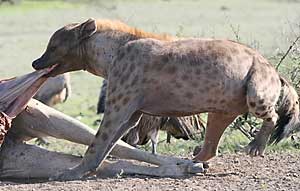Contact Details: Scotch Macaskill, Dirt Road Traders, Currys Post Road, Howick, KwaZulu-Natal, South Africa. Tel: +27 (0)82 578 2329. Privacy: Your privacy is guaranteed. See our Privacy Policy for more. This site accepts advertising and other forms of compensation - see Disclosure and Advertising for details. Site updated: 2022. Copyright © 2002 - 2022 Scotch Macaskill

| ||||||||||
|
||||||||||
|
See also info about: |
Spotted Hyena Information
The spotted hyena is the largest and most common hyena. Other members of the Hyaenidae family are the striped hyena (Hyaena hyaena), brown hyena (Hyaena brunnea), and aardwolf (Protelas cristatus). Appearance:
The head, neck and lower parts of the limbs are unspotted. This animal's head is massive and broad, with very strong jaws. The muzzle is dark brown, while the ears are small and rounded. There is a short crest of coarse hair from the head to the shoulders. The tail is bushy with a dark tip. Behavior:
Females are bigger and more aggressive than males, and females dominate in any social situation or occasion where there is competition for resources. See Spotted Hyenas Burdened with Hermaphrodite Myth for more about female hyena domination. Spotted hyenas are mainly nocturnal but are also often sighted during the day, especially in cool weather. They are territorial animals and mark their territories by anal gland pasting. Most of this is done by the males and young, low ranking females.
Reproduction: Spotted hyenas usually have from one to four pups which are born in the summer months after a gestation period of 110 days. Two or more females may keep the young in the same burrow for several months. The pups are born a dark brown colour with lighter heads. Spots begin to appear at four months old.
Diet: Spotted hyenas are renowned and highly successful scavengers, relying on scent and vultures circling overhead to find carcasses. They are, however, also accomplished hunters, killing up to 75% of their own prey. They usually target medium- to large-sized antelope. Spotted hyenas rely on their speed and stamina to run down their prey instead of stalking and can run as fast as 60km per hour over distances of four to five kilometers. They will also chase other predators, particularly cheetah, from their kills (see Cheetahs Surrender Kill to Pack of Hungry Hyenas).
Sounds:
For additional information about the spotted hyena, see our gallery of Hyena Pictures. Return to Wildlife Info . |
|||||||||
|
|
||||||||||

 Spotted hyena, close up of head and powerful jaws
Spotted hyena, close up of head and powerful jaws

